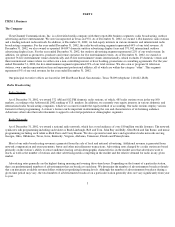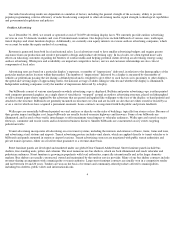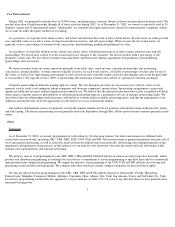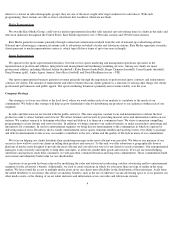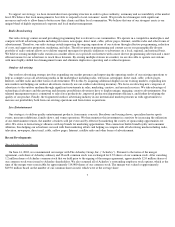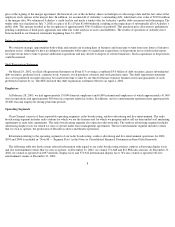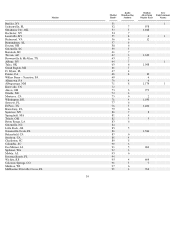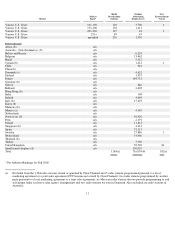iHeartMedia 2002 Annual Report Download - page 5
Download and view the complete annual report
Please find page 5 of the 2002 iHeartMedia annual report below. You can navigate through the pages in the report by either clicking on the pages listed below, or by using the keyword search tool below to find specific information within the annual report.
Live Entertainment
During 2002, we promoted or produced over 29,000 events, including music concerts, theatrical shows and specialized sporting events. We
reached more than 65 million people through all of these activities during 2002. As of December 31, 2002, we owned or operated a total of 76
domestic venues and 26 international venues. Additionally, we currently own equity interests in various live entertainment companies, which
we account for under the equity method of accounting.
As a promoter, we typically book talent or tours, sell tickets and advertise the event to attract ticket buyers. For the event, we either provide
our controlled venue or we rent a venue, arrange for production services, and sell sponsorships. When we provide our owned venue, we
generally receive a percentage of revenues from concessions, merchandising, parking and premium box seats.
As a producer, we typically develop event content, hire artistic talent, schedule performances in select venues, promote tours and sell
sponsorships. We do not have control over the actual ticket price charged to the consumer. We derive revenue from a percentage of the
promoters’ ticket sales. We also derive revenues from guarantees and from profit sharing agreements with promoters, merchandising,
sponsorships and concessions.
We derive revenues from our venue operations primarily from ticket sales, rental income, corporate sponsorships and advertising,
concessions, and merchandise. A venue operator typically receives, for each event it hosts, a fixed fee or percentage of ticket sales for use of
the venue, as well as fees representing a percentage of total concession sales from the vendors and total merchandise sales from the performer
or tour producer. We typically receive 100% of sponsorship and advertising revenues and a rebate of a portion of ticketing surcharges.
Corporate sponsorship includes the naming rights of venues. We also designate providers of concessions and “official” event or tour
sponsors such as credit card companies, phone companies and beverage companies, among others. Sponsorship arrangements can provide
significant additional revenues without significant incremental cost. We believe that the national venue network we have assembled will likely
attract major corporate sponsors and enable us to sell national sponsorship rights at a premium over local or regional sponsorship rights. We
also believe that our relationships with advertisers will enable us to better utilize available advertising space, and that the aggregation of our
audiences nationwide will create the opportunity for advertisers to access a nationwide market.
Our outdoor entertainment venues are primarily used in the summer months and do not generate substantial revenue in the late fall, winter
and early spring. The theatrical presenting season generally runs from September through May. Motor sports business operates primarily in the
winter.
Other
Television
As of December 31, 2002, we owned, programmed or sold airtime for 34 television stations. Our television stations are affiliated with
various television networks, including ABC, CBS, NBC, FOX, UPN, PAX and WB. Television revenue is generated primarily from the sale of
local and national advertising, as well as from fees received from the affiliate television networks. Advertising rates depend primarily on the
quantitative and qualitative characteristics of the audience we can deliver to the advertiser. Our sales personnel sell local advertising, while
national sales representatives sell national advertising.
The primary sources of programming for our ABC, NBC, CBS and FOX affiliated television stations are their respective networks, which
produce and distribute programming in exchange for each station’s commitment to air the programming at specified times and for commercial
announcement time during the programming. We supply the majority of programming to our UPN, PAX and WB affiliates by selecting and
purchasing syndicated television programs. We compete with other television stations within each market for these broadcast rights.
We also provide local news programming for the ABC, CBS, NBC and FOX affiliate stations in Jacksonville, Florida; Harrisburg,
Pennsylvania; Memphis, Tennessee; Mobile, Alabama; Cincinnati, Ohio; Albany, New York; San Antonio, Texas; and Salt Lake City, Utah.
Local news programming traditionally has appealed to a target audience of adults 25 to 54 years of age. Because these viewers generally have
increased buying power
5



